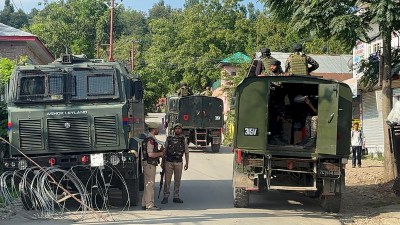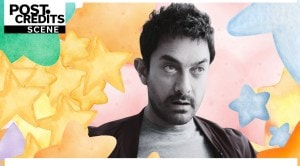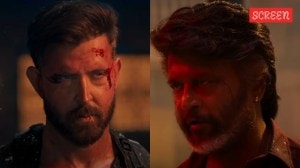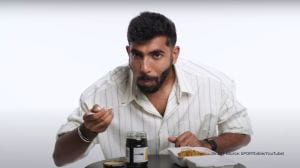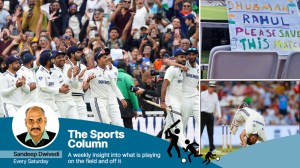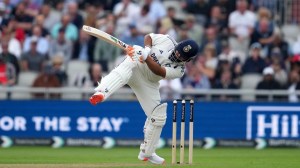Click here to follow Screen Digital on YouTube and stay updated with the latest from the world of cinema.
Spadikam: The story of a ‘Tiger’ who turned an ambitious teenager into Aadu Thoma, a rowdy worth just an ‘otta kaal anna’
Though Mohanlal’s character Aadu Thoma is as macho as his Neelakandan, Jagannadhan, Induchoodan, and Karthikeyan, or perhaps even a little more daring than any of them, Spadikam is far more than the films that depended solely on the mundu-clad, moustache-twirled hero.
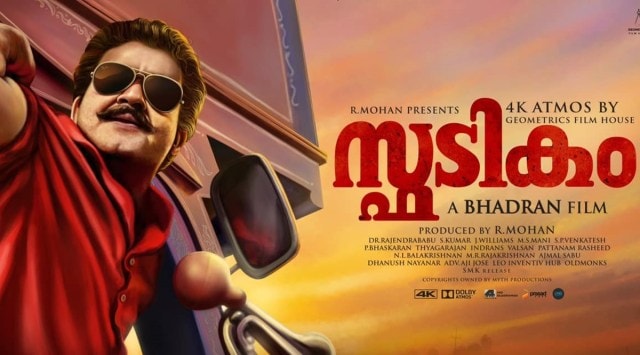 Mohanlal starrer Spadikam has hit screens once again.
Mohanlal starrer Spadikam has hit screens once again. Before he descended into the depths of mediocrity and shoddiness, there was a Mohanlal that Malayalis grew up watching. He was not the ‘complete actor’ but the one with the artistic ability to blur the line between the real and the reel. An actor who brought to screen the tragic hero Sreekuttan (Ninnistham Ennishtam), the hilarious Shambu (Mazha Peyyunnu Maddalam Kottunnu), the astute DySP Achuthankutty (Kariyilakkattu Pole), don Shobhraj, the desperate Gopalakrishna Panikkar (Sanmanassullavarkku Samadhanam), the breathtaking Harishankar (Deshadanakkili Karayarilla), the lovable T P Balagopalan, the cold-blooded Vincent Gomes (Rajavinte Makan), the daring Sunny (Sukhamo Devi), the mentally-disturbed Vinu (Thalavattam), and the ultimate heartthrob Solomon (Namukku Parkkan Munthirithoppukal), all in the same year (1986).
Characters of the highest calibre continued to come his way even after he got trapped in a cycle of overtly masculine roles since Devaasuram (1993), and the actor then made good decisions, unlike today. And one such film is Spadikam (The Shining Crystal). Although his character Aadu Thoma is as macho as Neelakandan (Devaasuram), Jagannadhan (Aaraam Thampuran), Induchoodan (Narasimham), and Karthikeyan (Raavanaprabhu), or perhaps even a little more daring than any of them, Spadikam is much more than the movies that relied solely on the mundu-clad, moustache-twirled hero whose only job is to deliver power-packed dialogues.
Released on March 30, 1995, Spadikam (or Spatikam, as per the title card) was re-released on February 9, 2023, with a digitally remastered 4K Dolby Atmos version. The film, directed by Bhadran and produced by R Mohan through Shogun Films (formerly GoodKnight Films), was a tremendous hit when it came out for the first time almost 28 years ago. The movie helped Mohanlal win his third Kerala State Film Award for Best Actor in addition to becoming one of the biggest-grossing Malayalam movies of the year.
The film’s success continued even after that. The work as a whole and the character Aadu Thoma have grown to be household names over time. It is also one of the most lauded films in the professional careers of many people associated with it, starting with director Bhadran and the lead actor Mohanlal to actors Thilakan, Urvashi, Spadikam George, KPAC Lalitha, Nedumudi Venu, Karamana Janardanan Nair, cinematographers J Williams and S Kumar, stunt master Thyagarajan, still photographer N L Balakrishnan, and many others.
Not another tale of a hypermasculine ‘saviour’
One of the main features that helped Spadikam garner the status it enjoys today is that it does not tell the story of a feudal ‘saviour’, born to protect a group of privileged people and their trifling problems, or his rivalry with another feud.
At its core, the film is about the tumultuous relationship between a stringent, narcissistic father and his son, whose life has gone to rack and ruin as a result of the former’s ‘dictatorial’ approach towards him.
Unlike Mohanlal’s other macho characters that wear their Savarna pride on their sleeve, Thomas Chacko aka Aadu Thoma hails from a Christian family as the son of retired school headmaster C P Chacko (Thilakan) and his wife Mary (KPAC Lalitha).
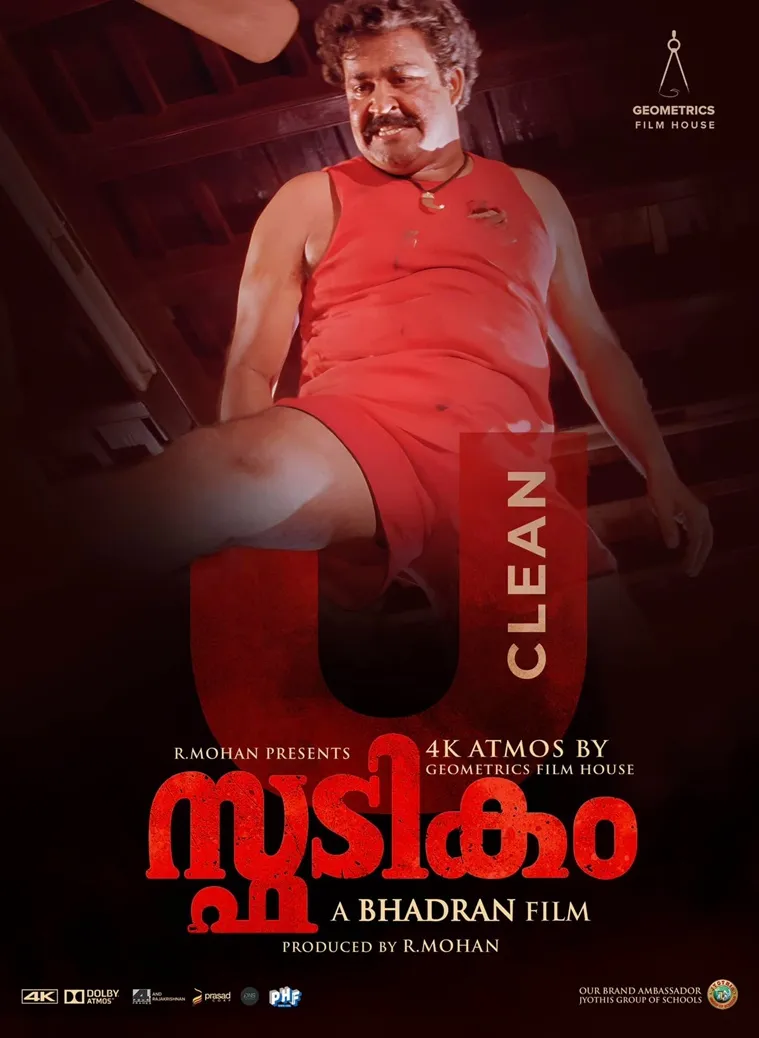 Mohanlal as Aadu Thoma in Spadikam. (Photo: Bhadran Mattel/Facebook)
Mohanlal as Aadu Thoma in Spadikam. (Photo: Bhadran Mattel/Facebook)
Thoma, a lorry driver, is the go-to person for the locals in distress. Thomachayan (a portmanteau of his name Thoma and the word ‘Ichayan’ used by Kerala Christians to refer to someone they respect), as he is dearly called, never shies away from helping anyone.
The first scene in the movie shows the man lying unconscious in the middle of a quarry, soaked in blood. Once Thoma regains consciousness, he rushes to those who attacked him by sprinkling chili powder in his eyes and beats them to a pulp. It is soon revealed that Thoma was beaten up for giving protection to a tutorial college lecturer when he was being evicted forcibly from his institute by the owner of the building.
“Thomachayan needs just a handful of blood from the heart of a black goat to regain strength. He can fight even an elephant after that. He is a man with two hearts!” says the character Gafoor to police officers.
The film also shows Thoma under trial for an ‘attempt to murder’ case. He was booked in this case for thrashing a sub-inspector who tried to molest a woman trader.
At the same time, neither is Thoma an ideal human being nor does he lecture anyone about his life or the circumstances that pushed him into what he has become today, “a rowdy worth just an otta kaal anna (a coin with a hole in the centre that was used in British India, worth 25 paise),” according to his father. These traits are completely absent in the actor’s other similar characters. Thoma has multiple shades of grey, and he is neither proud nor disgusted by them. He is drunk all the time, gets into fights often, has an affair with a sex worker, seldom has any money, and has several police cases against him. But Thoma has almost embraced his current identity, which is nothing like the one he had dreamt of while growing up.
(Not) Like Father, Like Son
We are soon introduced to his family, which comprises his father, mother, and little sister Jancy.
There aren’t many Malayalam movies that successfully depict the temperament of two characters and their relationship with each other in the duo’s first combination scene itself, but Spadikam does it so elegantly.
Thoma arrives home while his father, Chacko master, whom people call Kaduva (Tiger) referring to his bestial character, is lecturing his students on the importance of paying attention to his classes.
“If Chacko master is teaching, even a donkey will learn mathematics. Your parents send you all here to study; mind it!” says the tutor to his students, hearing which Thoma, while passing by the former’s tuition centre, spits hard on the ground out of scorn.
The movie immediately shows how close Thoma is with his mother and sister and how loving a son/brother he is, highlighting that he has problems only with his father, whose initials (ironically) read “CP”, an attempt by the makers to show that he is just like Sir C P Ramaswami Iyer, the Diwan of erstwhile Travancore, who was infamous for imposing some widely disregarded policies upon the people of the kingdom.
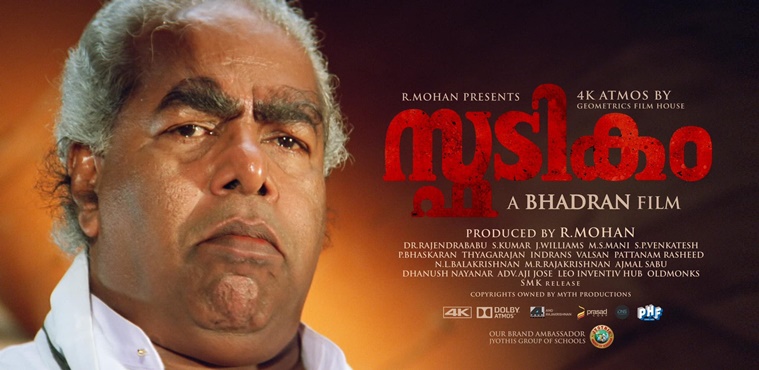 Later actor Thilakan as Chacko master in Spadikam. (Photo: Bhadran Mattel/Facebook)
Later actor Thilakan as Chacko master in Spadikam. (Photo: Bhadran Mattel/Facebook)
It quickly becomes apparent that Thomas Chacko did not choose to become Aadu Thoma. Thomas Chacko was an ambitious boy growing up. He wanted to become an inventor. But his hopes were crushed by Chacko master, who forced his dreams on his son. The flashback scenes showing Chacko master’s harsh and authoritarian teaching techniques used to ‘mould’ his son into a world-renowned mathematician are so disheartening and (unfortunately) relatable to many.
Although each of these flashback scenes is well-made and powerful, one specific scene perfectly captures the relationship between Thomas and Chacko master across their entire existence.
A teen Thomas Chacko is busy working on something in his atelier, set up in the attic of his house. While sweating profusely but not losing concentration, Thomas melts a metal wire and attaches it to the main circuit board of his creation using a soldering iron. He then puts the entire board inside a small soap case and starts turning the plastic shaft attached to it. Accompanied by static, a Hindi song starts playing from the soap case – it’s Mohammed Rafi! “Teri aankhon ke siva duniya mein rakha kya hai…”
Thomas runs up to his mother and shows her his new creation. While the two were listening to Rafi’s voice, Chacko master walks in and asks where he got the radio from, to which the teen replies that he made it. A furious Chacko master snatches the radio from him and tosses it into a blazing stove, melting another one of the kid’s dreams.
Chacko master is not an ideal teacher either. He has a partiality towards the bright student, Balu, whom he praises every now and then only to insult his son who is not great in mathematics.
Unable to bear the humiliation any longer, Thomas Chacko attacks Balu one day by piercing a compass on his palm, not out of hatred, but out of jealousy that Chacko master is showing Balu the care and affection that Thomas never received, and flees his native village, only to return a few years later as a thug.
From Chacko master cutting Thoma out of his will, beating the latter black and blue with a cane and handing him over to the police, repainting the name board of his son’s lorry with the word Chekuthan (Devil), insulting Thoma in the church while pretending to invite him for the wedding of Jancy, and planting a coconut tree named after Thoma in front of their house, to Thoma chopping off the sleeves of his father’s shirts, symbolically showing that he wants to cut off the cane-wielding hands of his father, picking up a handful of sand from beneath the coconut tree to sprinkle it above Chacko master’s coffin in the future, and him celebrating after his mother Mary leaves his father, there are several moments in the movie that firmly portray the turbulent relationship between the two.
A tight script and well-written characters go a long way
The film progresses further showing Thoma’s rivals trying to eliminate him through various means and how the former faces all the hurdles single-handedly. But the movie never becomes just about that and keeps its prime focus on the father-son relationship itself. Simultaneously, it also shows the protagonist’s bond with characters such as Ravunni (Nedumudi Venu), Thomas’ former Malayalam teacher who resigned from his school as he was unable to bear the guilt of failing Thomas in one of the exams as per instructed by Chacko master, Ravunni’s daughter Thulasi (Urvashi), Thomas’ high-school sweetheart, Manimala Vakkachan (Rajan P Dev), Thomas’ paternal uncle, and Father Ottaplakkan (Karamana Janardanan), the local priest. Thoma’s reconciliation with Thulasi, played by an ever-mesmerising Urvashi, and how she slowly brings out the Thomas Chacko that Aadu Thoma had locked up inside his heart are some of the most heartwarming scenes.
While all these actors put in a lot of blood, sweat, and tears to make their characters pitch perfect, Bhadran’s obdurate script and Dr Rajendrababu’s trenchant dialogues are the factors that form Spadikam’s sturdy foundation.
Up until the 54th minute of the film, we only see Aadu Thoma, who electrifies the audience with his toughness. Moments before Chacko master hands him over to the police, as the former is beating Thoma up with a cane in real time, the film intercuts to flashback shots showing a young Thomas Chacko being vigorously caned by his father for not learning mathematical equations. Until then, the viewers are only given the idea that Chacko master is a strict teacher and Thoma an irreverent son. However, it is at this point that we also learn how Thomas Chacko changed into Aadu Thoma. All of the flashback intercuts are skillfully placed, and the director uses the same strategy throughout the entire film.
 Spadikam is helmed by Bhadran. (Photo: Bhadran Mattel/Facebook)
Spadikam is helmed by Bhadran. (Photo: Bhadran Mattel/Facebook)
In a 2019 episode of Safari TV’s autobiographical show Charithram Enniloode, Bhadran said, “I worked on Spadikam’s script for close to three years. Rewrote it several times. That is probably why it is still a memorable film. Parenting is the central theme of the movie. It talks about how a father or teacher should raise his son/student. The father’s redemption, not the rowdy’s, is the focus of the movie’s conclusion. Even the movie’s title, Spadikam, is written from the father’s point of view. Instead of being about Aadu Thoma, the movie is about how he came to be.”
“When the movie starts, Thoma’s lorry is called Mary Dasan. Then his father alters it, arguing that Thoma is unworthy of using his mother’s name, and gives the vehicle the name Chekuthan. Towards the end of the film, he realises that his son was never a devil but a shining crystal instead and rechristens the lorry Spadikam,” Bhadran told Manorama Online.
At the same time, not a single one of the movie’s primary characters is ‘simply there’ for no reason. All of them have proper character arcs and/or contribute to the story in one way or another.
While Dr Rajendrababu gave Mohanlal some unforgettable dialogues like “Ithu ente puthan Ray-Ban glass. Ithu chavitti pottichal, ninte kaalu njan vettum” (These are my new Ray-Ban glasses. If you break them, I will chop your legs!), “Ee poottinte molil nee ninte poottittu poottiyal, ninne njan poottum… Odukkathe poottu” (If you put your lock over this lock, I will lock you once and for all), “Thoma chettayalla” (Thoma is not scoundrel), and “Iniyum njan varum. Cemeteryil… Ningade kuzhiyil mannidan. Ee pathinettam pattayude chottil ninnu aakatte makante oru pidi mannu” (I will come again. To the cemetery… to throw sand on your coffin. Let that handful of sand be from beneath this coconut tree itself), even the other characters received potent dialogues. And thanks to the perfect casting, they are all equally impactful.
Spadikam is one of the few instances where the relationships between all of the characters are incredibly attractive. It is not often that we get to watch a movie where all of the characters have enticing chemistry.
It’s all about teamwork
The location of Spadikam is among its outstanding qualities. Spadikam, in contrast to many movies of the era, was totally filmed in and around Changanassery in Kerala’s Kottayam district. Neither were any of the houses shown in the film old Namboothiri mansions, nor were the locales glaringly elite. The entire narrative takes place in settings that many Malayalis are all too familiar with.
No one scene in the movie feels out of place because of how well Bhadran’s locations fit the narrative and tone of the picture. The town’s spirit was brilliantly captured by cinematographers J Williams and S Kumar, and editor M S Mani produced a polished final output.
In an interview with Malayalam digital news portal CAN Channel, Bhadran stated that “Cinematographer Williams was one of the key reasons we were able to capture the stunt sequences in the movie so wonderfully. Williams had to be kind of replaced even though close to 40 to 50 per cent of the filming had already been completed because the other crew members were unhappy with the way he was treating them. That’s how we roped in S Kumar. But we brought back Williams towards the end to shoot a few fight scenes in a quarry.”
Thyagarajan Master’s action choreography is likewise deserving of special praise. Thyagarajan choreographed fantastic action sequences in the movie, despite the fact that Mohanlal had already made multiple action movies by that point and that the actor rose to stardom through a gangster film, Rajavinte Makan. The highlight, however, was Bhadran’s brainchild, ‘Aadu Thoma’s Thuni parichadi’, wherein he pulls his mundu and covers his rival’s head with it before continuing the fight.
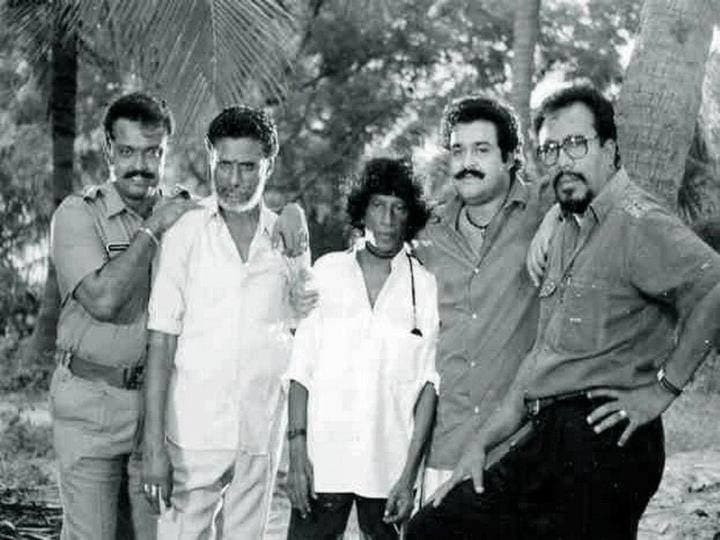 Bhadran and Mohanlal with other crew members on the sets of Spadikam. (Photo: Bhadran Mattel/Facebook)
Bhadran and Mohanlal with other crew members on the sets of Spadikam. (Photo: Bhadran Mattel/Facebook)
The film’s songs and background score composed by S P Venkatesh are still spellbinding. Who can forget the song “Ezhimala Poonchola” that was graced by the ever-glorious Silk Smitha with her enthralling dance moves? The film features three songs, all of which were sung by the magnificent K S Chithra.
Even Mohanlal’s stills from the film, captured by N L Balakrishnan, have become iconic over the years.
However, Bhadran has time and again said that the process of getting the project in motion wasn’t a stroll in the park.
Before R Mohan of Shogun Films joined the project, Bhadran discussed the plot with G P Vijayakumar of Seven Arts International Limited, who had serious issues with certain of Aadu Thoma’s characteristics.
In an interview with The Cue Studio on the occasion of the film’s 25th anniversary, Bhadran said, “After hearing the story, Vijayakumar told me he had some strong objections. His first complaint was regarding Aadu Thoma’s habit of drinking blood from the hearts of goats. He felt that it was repulsive. Second, he felt that Thoma chopping off the sleeves of his father’s shirts was a bit too much. Finally, he said that the audience won’t like it if Mohanlal pulls off his mundu during fights. He said that the audience would boo it. Though I tried to convince Vijayakumar, he strongly objected to these things. I got offended. I immediately contacted Mohan, to whom I had previously narrated the story. I asked Mohan if he still wanted to produce the film, and he immediately said yes.”
“Not only did Vijayakumar question me if this would work; several other people in the film industry did as well. They were unsure whether anyone would believe such a father-son relationship. But Mohanlal understood the story, as did producer Mohan. When I told him the story, even my mentor and veteran film director Hariharan showed concern about it. But after seeing the movie, he conceded that the story is what makes it so good. Vijayakumar watched the movie on the first day itself. He came and met me afterwards and said that I was right. He saw how people went bonkers watching the ‘Thuni parichadi’ and admitted that his assumptions were wrong.”
“People frequently ask me if they may anticipate films from me similar to Spadikam. I give the same response to everyone – No! Spadikam was more than just a fight show, right? It had life lessons… It had an era… It had characters representing that era… Characters representing the fathers, sons, teachers, and students of that era… As ‘Thuni parichadi’, wearing Ray-Ban glasses, attacking police officers inside stations and drinking blood from the heart of goats are the result of the aforementioned factors, Spadikam became a believable film,” he added.
The return after 28 years
On February 9, Spadikam was re-released in more than 500 theatres globally and more than 150 theatres in the state of Kerala, just as Malayalis were already going bonkers over the comeback of Thomachayan after 28 years.
Aaduthoma 🔥 back to our Screen after long 28 years!#Spadikampic.twitter.com/Mwq2e4Iccg
— Apsara 4K Kozhikode (@ApsaraTheatre) February 9, 2023
Bhadran said that the revised version was over eight and a half minutes longer than the original in an interview with Onmanorama. “I along with a few friends, had spent around Rs 2 crore, through a company called Geo Matrix, to re-release Spadikam in the theatres,” the veteran filmmaker told Onmanorama. According to him, the movie wouldn’t have an OTT or a satellite release for at least three years.
According to Reporter Live, record ticket sales for the movie are already being seen at various theatres in Kerala, including Thrissur’s Ragam, Kozhikode’s Apsara, Kottayam’s Abhilash, and Thiruvananthapuram’s Ariesplex.


Photos




- 01
- 02
- 03
- 04
- 05



